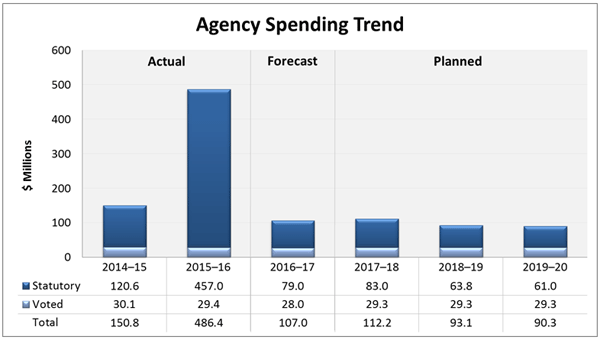2017–18 Departmental Plan
Spending and Human Resources
Elections Canada's Financial Framework
Elections Canada's unique dual funding mechanism and planning practices are a function of its mandate. The agency is funded in part by an annual appropriation that covers the salaries of its indeterminate positions and is not affected by the electoral cycle. The agency also has a statutory authority that allows it to draw directly from the Consolidated Revenue Fund for all other expenses. The statutory authority serves to recognize Elections Canada's independence from the government. It also ensures that Elections Canada has access to the funds required for elections that may occur at any time.
Under Canada's parliamentary system, general elections are scheduled to take place on fixed dates but can still be called in advance. This is particularly the case in a minority government situation. By-elections, which take place whenever seats in the House of Commons become vacant, are also unpredictable. For these reasons, Elections Canada does not normally forecast election readiness and delivery activities.
Planned Spending

Totals may not add up due to rounding.
Agency Spending Trend – Text version
| Programs and Internal Services | 2014–15 Expenditures |
2015–16 Expenditures |
2016–17 Forecast Spending |
2017–18 Main Estimates |
2017–18 Planned Spending |
2018–19 Planned Spending |
2019–20 Planned Spending |
|---|---|---|---|---|---|---|---|
| Electoral Operations | 90,292,796 | 331,586,802 | 48,566,302 | 53,556,884 | 53,556,884 | 39,431,253 | 36,663,769 |
| Regulation of Electoral Activities | 18,101,587 | 116,777,324 | 13,901,273 | 11,219,651 | 11,219,651 | 9,248,769 | 9,244,062 |
| Electoral Engagement | 8,261,985 | 8,244,303 | 8,723,030 | 9,279,980 | 9,279,980 | 8,941,792 | 8,653,721 |
| Subtotal | 116,656,368 | 456,608,429 | 71,190,605 | 74,056,515 | 74,056,515 | 57,621,814 | 54,561,552 |
| Internal Services | 34,110,007 | 29,797,925 | 35,806,083 | 38,151,475 | 38,151,475 | 35,448,730 | 35,731,739 |
| Total | 150,766,375 | 486,406,354 | 106,996,688 | 112,207,990 | 112,207,990 | 93,070,544 | 90,293,291 |
The agency spending fluctuation is dictated mostly by election dates. As the 42nd general election was held on October 19, 2015, the peak of expenditures required for its conduct was in 2015–16, and there were higher expenditures in 2014–15, when activities required to achieve operational readiness took place. In the years following an election, expenditures drop sharply, returning to their usual level as election activities wind down. This pattern is a result of the election cycle and is typical for the agency. In 2016–17, Elections Canada initiated a process for asset renewal and electoral services modernization; the bulk of the expenditures will be incurred in 2017–18, and expenditures will then diminish until 2019–20. These variations affect only the statutory portion of the funding.
Planned Human Resources
| Programs and Internal Services | 2014–15 Full-Time Equivalents |
2015–16 Full-Time Equivalents |
2016–17 Forecast Full-Time Equivalents |
2017–18 Planned Full-Time Equivalents |
2018–19 Planned Full-Time Equivalents |
2019–20 Planned Full-Time Equivalents |
|---|---|---|---|---|---|---|
| Electoral Operations | 309 | 444 | 273 | 257 | 229 | 220 |
| Regulation of Electoral Activities | 70 | 81 | 87 | 75 | 71 | 71 |
| Electoral Engagement | 57 | 68 | 71 | 67 | 67 | 67 |
| Subtotal | 436 | 593 | 431 | 399 | 367 | 358 |
| Internal Services | 120 | 131 | 153 | 152 | 148 | 152 |
| Total | 556 | 724 | 584 | 551 | 515 | 510 |
The FTE fluctuation, like the agency's spending, is dictated mostly by election dates. During 2016–17 most post-election activities took place, including reporting, evaluation, and the audit of candidate election returns. Also in 2016–17, Elections Canada initiated a process for asset renewal and electoral services modernization, with the majority of FTEs being planned for 2017–18.
Estimates by Vote
For information on Elections Canada's organizational appropriations, consult the 2017–18 Main Estimates.Footnote xiii
Future-Oriented Condensed Statement of Operations
The Future-Oriented Condensed Statement of Operations provides a general overview of Elections Canada's operations. The forecast of financial information on expenses and revenues is prepared on an accrual accounting basis to strengthen accountability and to improve transparency and financial management.
Because the Future-Oriented Condensed Statement of Operations is prepared on an accrual accounting basis, and the forecast and planned spending amounts presented in other sections of the Departmental Plan are prepared on an expenditure basis, amounts may differ.
A more detailed Future-Oriented Statement of Operations and associated notes, including a reconciliation of the net cost of operations to the requested authorities, can be found on Elections Canada's website.Footnote xiv
| Financial Information | 2016–17 Forecast Results |
2017–18 Planned Results |
Difference (2017–18 Planned Results Minus 2016–17 Forecast Results) |
|---|---|---|---|
| Total expenses | 116,387,828 | 116,744,369 | 356,541 |
| Total revenues | - | - | - |
| Net cost of operations before government funding and transfers | 116,387,828 | 116,744,369 | 356,541 |
Elections Canada estimates about the same level of expenses for both 2016–17 and 2017–18.
